Evaluation of the Spirituality of Village Committees on Integrated Risk Governance of Agricultural Drought: A Case Study in Xindu District, Hebei Province, China
Abstract
1. Introduction
2. Data and Methods
2.1. Overview of the Study Area
2.2. Field Research
2.3. Research Methodology
2.3.1. Research Framework
2.3.2. Integrated Risk Evaluation of Agricultural Drought
2.3.3. Quantitative Model of Spirituality
3. Results
3.1. Analysis of Spirituality Indicators on Integrated Risk Governance
3.2. Regional Regularity Analysis of Spirituality Based on Geomorphology
3.3. Regional Regularity Analysis of Spirituality Based on Agricultural Drought Risk Level
3.4. Regional Regularity Analysis of Spirituality Based on per Capita Income Level
4. Conclusions
5. Discussion
5.1. Coupling Study of Spirituality and Consilience
5.2. Exploration of Spirituality Influence Factors
5.3. The Influence of Local Administrative System
Author Contributions
Funding
Institutional Review Board Statement
Informed Consent Statement
Data Availability Statement
Acknowledgments
Conflicts of Interest
References
- Compilation group of China Flood and Drought Disaster Prevention Bulletin. Summary of China Flood and Drought Disaster Prevention Bulletin 2021. China Flood Drought Manag. 2022, 32, 38–45. (In Chinese) [Google Scholar] [CrossRef]
- Brunner, M.I.; Slater, L.; Tallaksen, L.M.; Clark, M. Challenges in modeling and predicting floods and droughts: A review. Wiley Interdiscip. Rev. Water 2021, 8, e1520. [Google Scholar] [CrossRef]
- Sarker, M.N.I.; Wu, M.; Alam, G.M.M.; Shouse, R.C. Administrative resilience in the face of natural disasters: Empirical evidence from Bangladesh. Pol. J. Environ. Stud. 2020, 29, 1825–1837. [Google Scholar] [CrossRef]
- Jamroni, M.; Sukesi, K.; Yuliati, Y.; Purnomo, M. Village Community Resilience in Handling the COVID-19 Pandemic. Multicult. Educ. 2021, 7, 155–170. [Google Scholar]
- Garg, N. Workplace spirituality and employee well-being: An empirical exploration. J. Hum. Values 2017, 23, 129–147. [Google Scholar] [CrossRef]
- King, S.M. Religion, spirituality, and the workplace: Challenges for public administration. Public Adm. Rev. 2007, 67, 103–114. [Google Scholar] [CrossRef]
- O’Brien, M.E. Spirituality in Nursing: Standing on Holy Ground; Jones & Bartlett Publishers: Burlington, MA, USA, 2021. [Google Scholar]
- Paloutzian, R.F.; Park, C.L. The psychology of religion and spirituality: How big the tent? Psychol. Relig. Spiritual. 2021, 13, 3–13. [Google Scholar] [CrossRef]
- Koenig, H.G. Concerns about measuring spirituality in research. J. Nerv. Ment. Dis. 2008, 196, 349–355. [Google Scholar] [CrossRef]
- Ashmos, D.P.; Duchon, D. Spirituality at work: A conceptualization and measure. J. Manag. Inq. 2000, 9, 134–145. [Google Scholar] [CrossRef]
- Milliman, J.; Czaplewski, A.J.; Ferguson, J. Workplace spirituality and employee work attitudes: An exploratory empirical assessment. J. Organ. Chang. Manag. 2003, 16, 426–447. [Google Scholar] [CrossRef]
- Wang, T.-M.; van Witteloostuijn, A.; Heine, F. A Moral Theory of Public Service Motivation. Front. Psychol. 2020, 11, 517763. [Google Scholar] [CrossRef] [PubMed]
- Lee, Y.-H.; Salman, A. Evaluation of using the Chinese version of the spirituality index of well-being (SIWB) scale in Taiwanese elders. Appl. Nurs. Res. 2016, 32, 206–211. [Google Scholar] [CrossRef] [PubMed]
- Li, S.; Pan, Q.; Frey, B.B. Development of a Chinese and American scale for measuring spirituality. Cogent Psychol. 2018, 5, 1501934. [Google Scholar] [CrossRef]
- Bednarczuk, M. God in the workplace: Religiosity and job satisfaction among US public servants. J. Public Nonprofit Aff. 2019, 5, 261–276. [Google Scholar] [CrossRef]
- Lawson, E.J.; Thomas, C. Wading in the waters: Spirituality and older Black Katrina survivors. J. Health Care Poor Underserved 2007, 18, 341–354. [Google Scholar] [CrossRef]
- Captari, L.E.; Hook, J.N.; Aten, J.D.; Davis, E.B.; Tisdale, T.C. Embodied spirituality following disaster: Exploring intersections of religious and place attachment in resilience and meaning-making. In The Psychology of Religion and Place; Palgrave Macmillan: Cham, Switzerland, 2019; pp. 49–79. [Google Scholar]
- Wamsler, C. Stakeholder involvement in strategic adaptation planning: Transdisciplinarity and co-production at stake? Environ. Sci. Policy 2017, 75, 148–157. [Google Scholar] [CrossRef]
- Wamsler, C.; Brink, E. Mindsets for sustainability: Exploring the link between mindfulness and sustainable climate adaptation. Ecol. Econ. 2018, 151, 55–61. [Google Scholar] [CrossRef]
- Jiang, Y.; Wu, Y.Y.; Guo, H.; Zhang, G.M.; Wang, J.A. Consilience Researches of Agricultural Drought Integrated Risk Governance. J. Hebei Norm. Univ. (Nat. Sci.) 2021, 45, 410–417. (In Chinese) [Google Scholar] [CrossRef]
- Ke, J.L.; Sun, J.M.; Wang, J. Development and Validation of the Workplace Spirituality Scale. Chin. J. Clin. Psychol. 2014, 5, 826–830. (In Chinese) [Google Scholar] [CrossRef]
- Guo, H.; Jiang, Y.; Wang, J.A.; Liang, Q.O. Consistency of farmers’ planting strategies and government objectives fordrought risk governance: A case study of Xinghe County of Inner Mongolia. Resour. Sci. 2021, 43, 1889–1902. (In Chinese) [Google Scholar] [CrossRef]
- Wu, Y.; Guo, H.; Wang, J.A. Quantifying the Similarity in Perceptions of Multiple Stakeholders in Dingcheng, China, on Agricultural Drought Risk Governance. Sustainability 2018, 10, 3219. [Google Scholar] [CrossRef]
- Yang, D.G.; Zhou, Z.T.; Song, Y.Y.; Zhang, G.W.; Yang, G.L. Contemporary National Cohesion Study. Bull. Chin. Acad. Sci. 2016, 31, 1215–1223. (In Chinese) [Google Scholar] [CrossRef]
- Johnson, J. Social Cohesion: An Investigation into Post-Earthquake Christchurch. Bachelor’s Dissertation, Lincoln University, Lincoln, New Zealand, 2015. [Google Scholar]
- Townshend, I.; Awosoga, O.; Kulig, J.; Fan, H. Social cohesion and resilience across communities that have experienced a disaster. Nat. Hazards 2015, 76, 913–938. [Google Scholar] [CrossRef]
- Shi, P.J. Theory and practice on disaster system research in a fourth time. J. Nat. Disasters 2005, 6, 1–7. (In Chinese) [Google Scholar]
- Okada, N.; Tatano, H.; Hagihara, Y.; Suzuki, Y.; Hayashi, Y.; Hatayama, M.; Hartman, J.; Nagae, T.; Shimizu, H. Integrated research on methodological development of urban diagnosis for disaster risk and its applications. Annu. Disaster Prev. Res. Inst. Kyoto Univ. 2004, 47, 1–8. [Google Scholar]
- Diakoulaki, D.; Mavrotas, G.; Papayannakis, L. Determining objective weights in multiple criteria problems: The critic method. Comput. Oper. Res. 1995, 22, 763–770. [Google Scholar] [CrossRef]
- Zang, D.; Luo, Y. The heterogeneity of village cadres and poverty reduction. In Proceedings of the International Conference on Economic Management and Green Development (ICEMGD 2018), Beijing, China, 30 July 2018; pp. 1–5. [Google Scholar]
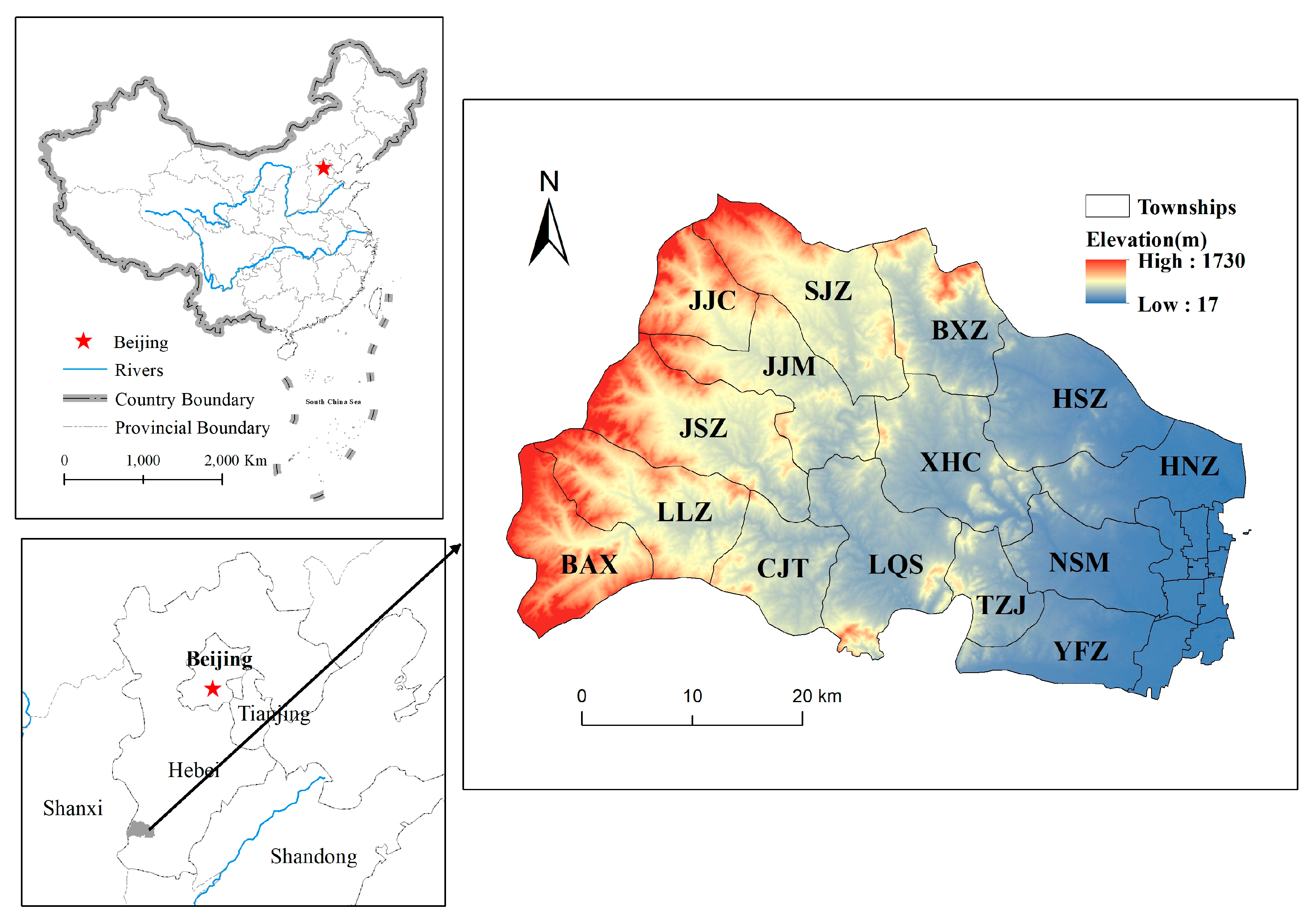

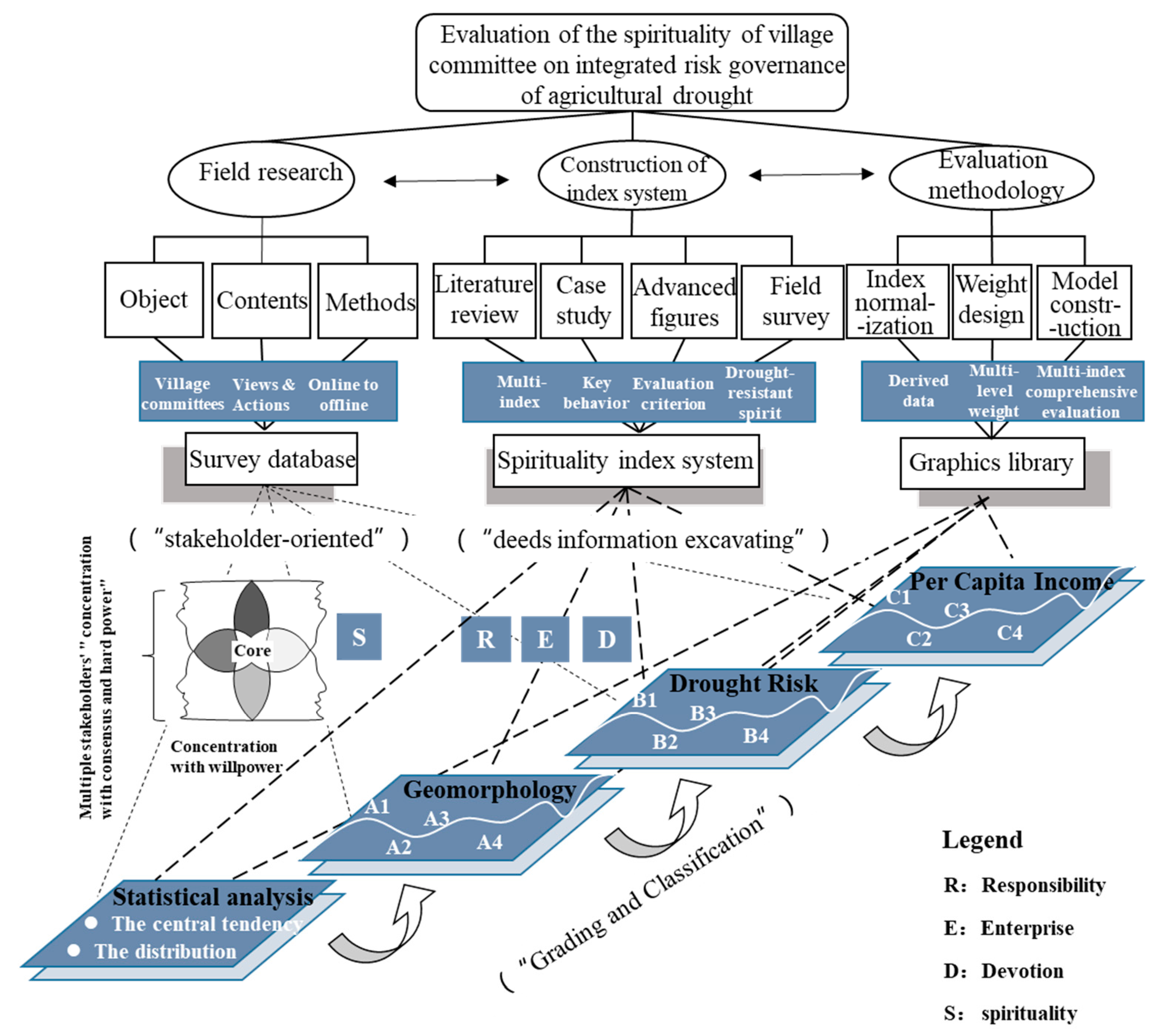
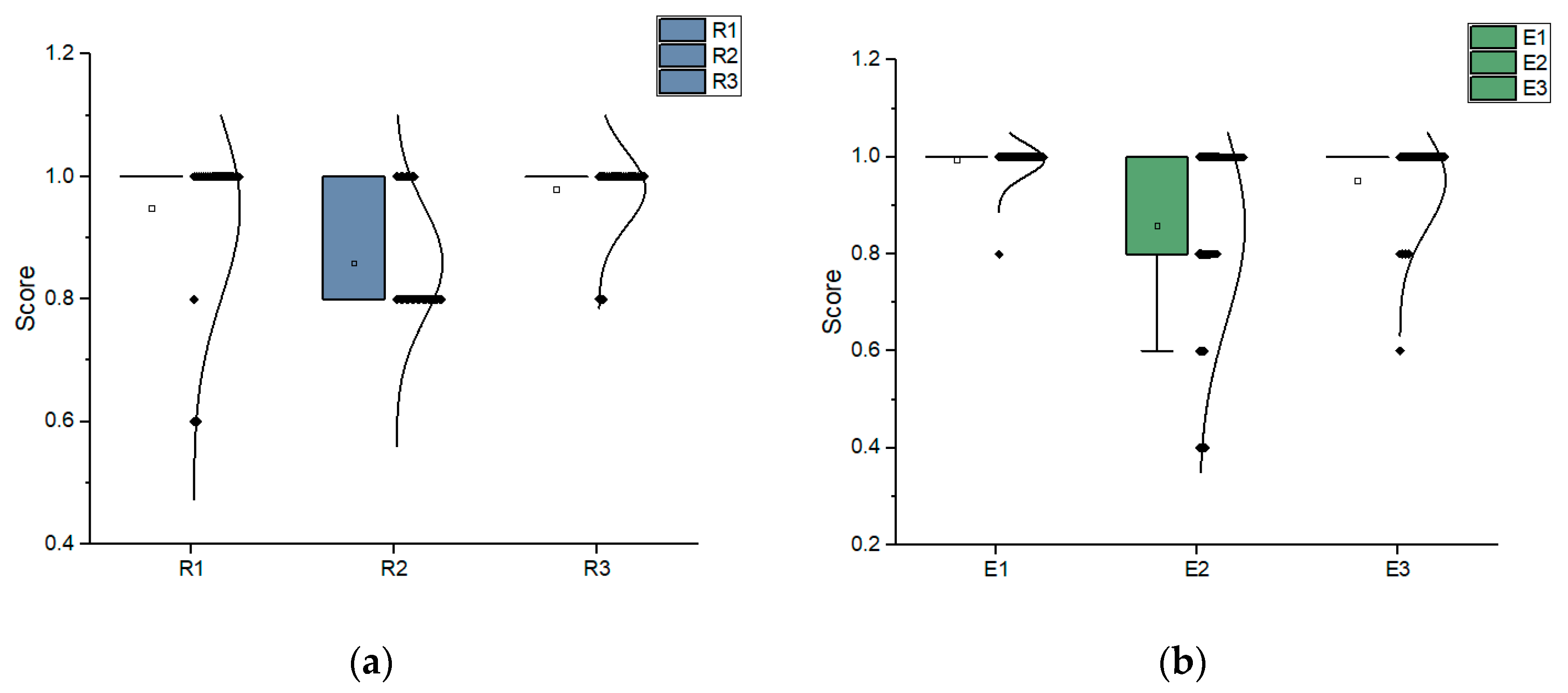

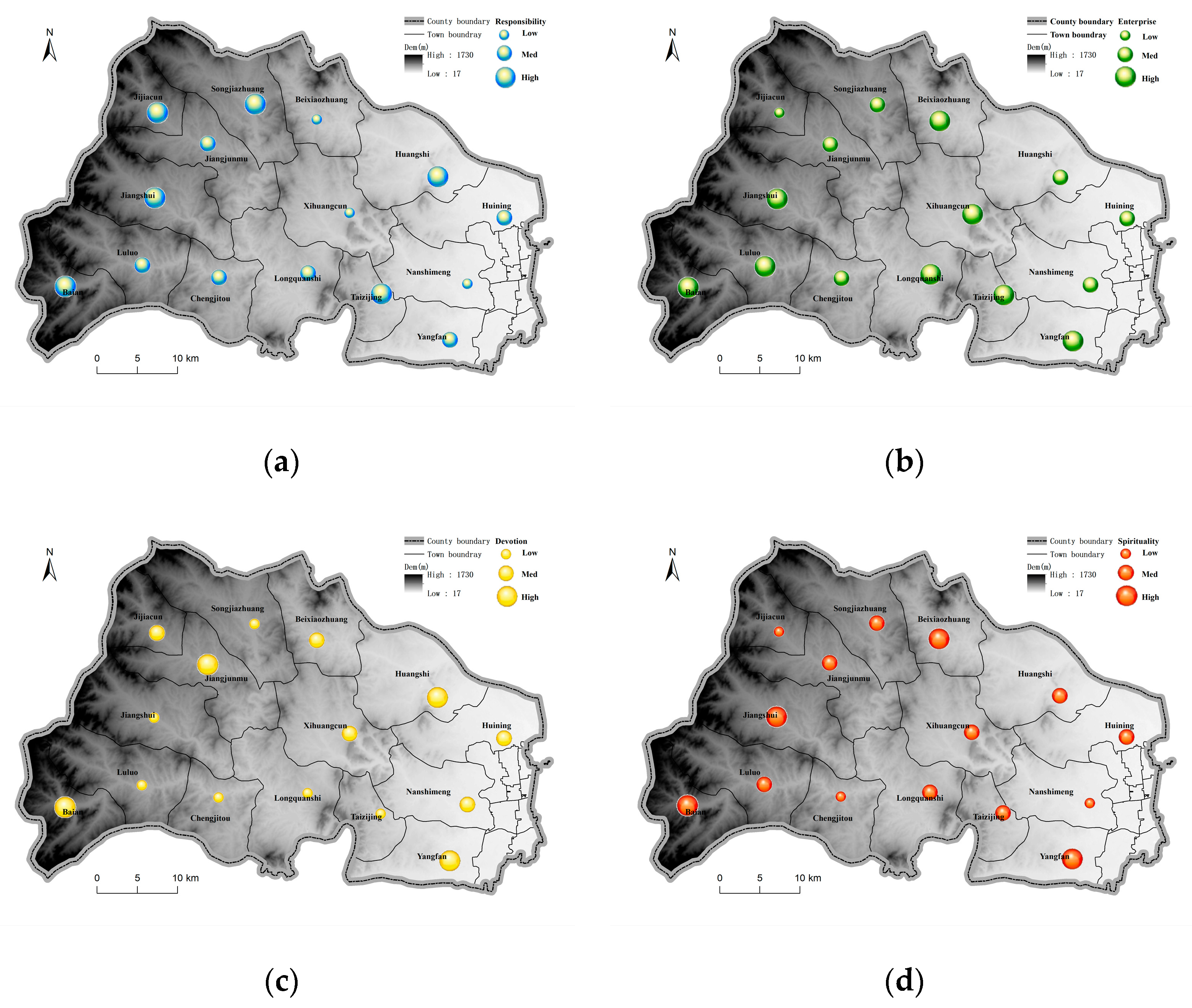

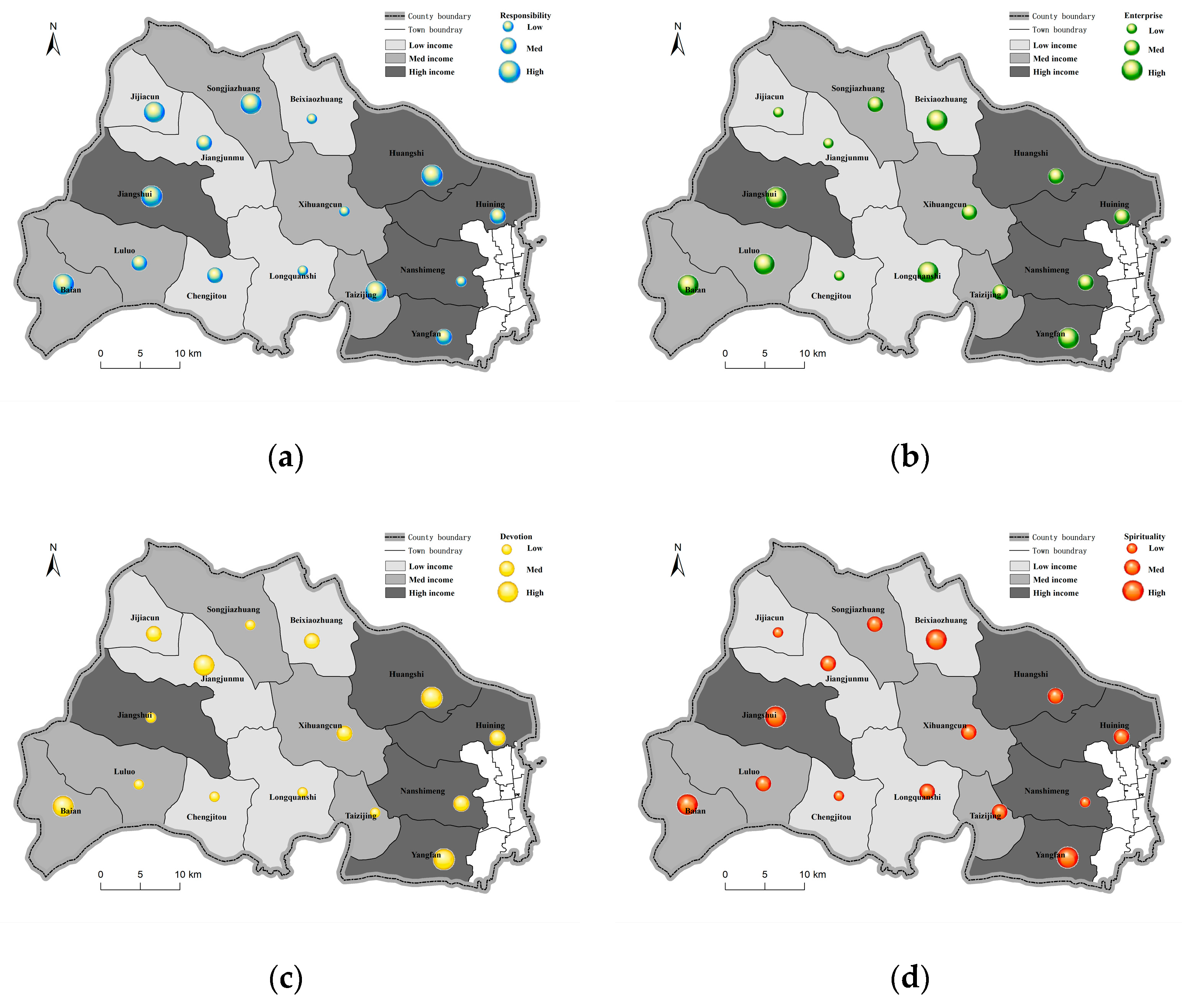
| First-Level Indicators (Weighting) | Second-Level Indicators (Weighting) | Specific Questions | |
|---|---|---|---|
| Spirituality(S) | Responsibility (R,0.31) | Inspection of disaster situation (R1,0.17) | During the drought, how did you inspect the situation? |
| Report a disaster (R2,0.08) | How timely was the reporting of the disaster during the drought? | ||
| Drought participation (R3,0.06) | How did you respond to the drought during the drought? | ||
| Enterprise (E,0.32) | Water allocation E1 (E1,0.03) | During the drought, in the case of limited water, if there are conflicts of grabbing water among the masses, how would you handle it? | |
| Manpower shortage (E2,0.19) | What do you do during a drought when there is not enough manpower to deliver water? | ||
| Insufficient equipment (E3,0.10) | What do you do if there is a shortage of drought equipment such as pumping, pipes or irrigation equipment during a drought? | ||
| Devotion (D,0.37) | Material contribution (D1,0.10) | If you need to lend your own pumping equipment and pipes to the public during a drought, how would you arrange it? | |
| Financial contribution (D2,0.15) | What will you do if there are people in need of relief during the drought? | ||
| Mindfulness contribution (D1,0.12) | How would you organize your drought efforts if you were seriously ill during the drought? |
| Catalog | Gender | Age | Work Experience | Education | ||||||||||
|---|---|---|---|---|---|---|---|---|---|---|---|---|---|---|
| Indicators | Male | Female | ≤40 | 41–50 | 51–60 | >60 | <5 | 5–10 | 10–15 | >15 | I | II | III | IV |
| Num. | 60 | 6 | 20 | 26 | 20 | 0 | 44 | 16 | 6 | 0 | 0 | 8 | 28 | 30 |
| R | Mountain | Hill | Plain | E | Mountain | Hill | Plain |
| high | 4(66.67%) | 2(40%) | 1(25%) | high | 3(50%) | 4(80%) | 1(25%) |
| medium | 2(33.33%) | 2(40%) | 2(50%) | medium | 2(33.33%) | 1(20%) | 3(75%) |
| low | 0(0%) | 1(20%) | 1(25%) | low | 1(16.67%) | 0(0%) | 0(0%) |
| D | Mountain | Hill | Plain | S | Mountain | Hill | Plain |
| high | 2(33.33%) | 0(0%) | 2(50%) | high | 2(33.33%) | 1(20%) | 1(25%) |
| medium | 1(16.67%) | 2(40%) | 2(50%) | medium | 3(50%) | 3(60%) | 2(50%) |
| low | 3(50%) | 3(60%) | 0 | low | 1(16.67%) | 1(20%) | 1(25%) |
| R | High Risk | Medium Risk | Low Risk | E | High Risk | Medium Risk | Low Risk |
| high | 2(40%) | 3(60%) | 2(40%) | high | 4(80%) | 0(0%) | 1(20%) |
| medium | 2(40%) | 2(40%) | 2(40%) | medium | 1(20%) | 4(80%) | 3(60%) |
| low | 1(20%) | 0(0%) | 1(20%) | low | 0(0%) | 1(20%) | 1(20%) |
| D | High risk | Medium risk | Low risk | S | High risk | Medium risk | Low risk |
| high | 1(20%) | 1(20%) | 2(40%) | high | 1(20%) | 1(20%) | 1(20%) |
| medium | 1(20%) | 0(0%) | 3(60%) | medium | 2(40%) | 1(20%) | 3(60%) |
| low | 3(60%) | 4(80%) | 0(0%) | low | 2(40%) | 3(60%) | 1(20%) |
| R | High Income | Medium Income | Low Income | E | High Income | Medium Income | Low Income |
| high | 2(40%) | 1(20%) | 1(20%) | high | 2(40%) | 1(20%) | 0(0%) |
| medium | 2(40%) | 1(20%) | 2(40%) | medium | 2(40%) | 4(80%) | 3(60%) |
| low | 1(20%) | 3(60%) | 2(40%) | low | 1(20%) | 0(0%) | 2(40%) |
| D | High income | Medium income | Low income | S | High income | Medium income | Low income |
| high | 2(40%) | 1(20%) | 1(20%) | high | 2(40%) | 1(20%) | 1(20%) |
| medium | 2(40%) | 1(20%) | 1(20%) | medium | 2(40%) | 4(80%) | 2(40%) |
| low | 1(20%) | 3(60%) | 3(60%) | low | 1(20%) | 0(0%) | 2(40%) |
Disclaimer/Publisher’s Note: The statements, opinions and data contained in all publications are solely those of the individual author(s) and contributor(s) and not of MDPI and/or the editor(s). MDPI and/or the editor(s) disclaim responsibility for any injury to people or property resulting from any ideas, methods, instructions or products referred to in the content. |
© 2023 by the authors. Licensee MDPI, Basel, Switzerland. This article is an open access article distributed under the terms and conditions of the Creative Commons Attribution (CC BY) license (https://creativecommons.org/licenses/by/4.0/).
Share and Cite
Jiang, Y.; Wu, Y.; Guo, H.; Zhang, G.; Wang, J. Evaluation of the Spirituality of Village Committees on Integrated Risk Governance of Agricultural Drought: A Case Study in Xindu District, Hebei Province, China. Sustainability 2023, 15, 4384. https://doi.org/10.3390/su15054384
Jiang Y, Wu Y, Guo H, Zhang G, Wang J. Evaluation of the Spirituality of Village Committees on Integrated Risk Governance of Agricultural Drought: A Case Study in Xindu District, Hebei Province, China. Sustainability. 2023; 15(5):4384. https://doi.org/10.3390/su15054384
Chicago/Turabian StyleJiang, Yao, Yaoyao Wu, Hao Guo, Guoming Zhang, and Jingai Wang. 2023. "Evaluation of the Spirituality of Village Committees on Integrated Risk Governance of Agricultural Drought: A Case Study in Xindu District, Hebei Province, China" Sustainability 15, no. 5: 4384. https://doi.org/10.3390/su15054384
APA StyleJiang, Y., Wu, Y., Guo, H., Zhang, G., & Wang, J. (2023). Evaluation of the Spirituality of Village Committees on Integrated Risk Governance of Agricultural Drought: A Case Study in Xindu District, Hebei Province, China. Sustainability, 15(5), 4384. https://doi.org/10.3390/su15054384






